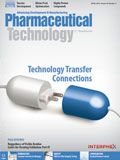Failure Mode Effects Analysis for Filter Integrity Testing
Understanding of the risks associated with FMEA is crucial in lot release testing.
The quality assurance of lot release in the biopharmaceutical industry is based to a great extent on integrity testing of used sterilizing-grade filters. If the integrity test fails, the product is put in quarantine and an investigation is conducted. The consistency of this quality assurance approach is based on the reliably executed integrity testing of the filters. One of the greatest risks are false-passed test results, which put the patient in danger.
From a more global point of view, the goal of failure mode effects analysis (FMEA) for filter integrity testing (FIT) is to align the risks as closely as possible with its source. This analysis can identify the root cause of the risk and help the quality assurance staff and operators detect the occurrence of a particular deviation. Additionally, the analysis also helps define the adapted level of training to reduce operator mistakes.
This article identifies risks for achieving a higher level of FMEA for FIT and for improved quality assurance.
Scope of the FMEA for FIT
The purpose of FMEA for FIT is to establish documentary evidence to assure that the manufacturing process is capable of producing the pre-determined quality specifications when using a specific tester for integrity testing of filters, while guaranteeing the safety of the operator.
Risk identification
Identifying risks and unwanted events, the potential consequences (severity/impact), the likelihood that the unwanted event will occur (probability), and the likelihood of detecting the unwanted event (detectability) require knowledge in FIT. The suppliers of the filters and testing device should provide supporting documentation that identifies the following risks.
Selecting the incorrect program or setting incorrect testing parameters
Selecting the wrong program or setting the wrong testing parameters could mean that the test pressure is wrong and/or the test limit is not adapted.
Incorrect test pressure
Different suppliers use different test pressures for the diffusion test, and different filter pore sizes require different test pressures. Mixing test pressures from different suppliers and test pressures for different pore sizes when setting the parameters for testing can lead to potential quality deviations.
Fick’s law gives the relation between applied differential pressure and diffusion for filters, under condition that all pores are filled with water. Fick’s law demonstrates that the diffusion value is not dependent on the pore size (µm) but the porosity (percentage of void) as long as the pores are filled with water. As long as the pores are filled with water, it is commonly considered to be a linear relation between the applied test pressure and the resulting diffusion value (1-2).
The porosity can be quite similar between a 0.1 µm and a 0.2 µm membrane. To detect different pore sizes, the diffusion test pressure for a filter with a given pore size (e.g., 0.1 µm) is selected so that a filter with a bigger pore size (e.g., 0.2 µm) would give a failing test result, even if the filter with the bigger pore size (0.2 µm) is integer. In other words, the diffusion test pressure of a 0.1 µm cartridge (4 bar) is close to or above the expected bubble point (BP) of a 0.2 µm membrane (BPmin = 3.2 bar; expected BP = 3.7 to 3.9 bar).
If a 0.1 µm membrane cartridge is tested at a pressure that is significantly lower than the expected bubble point for a 0.2 µm membrane cartridge, one Figure 1).
Figure 1: 0.1 μm vs. 0.2 μm pore size membrane filters. BP is bubble point.
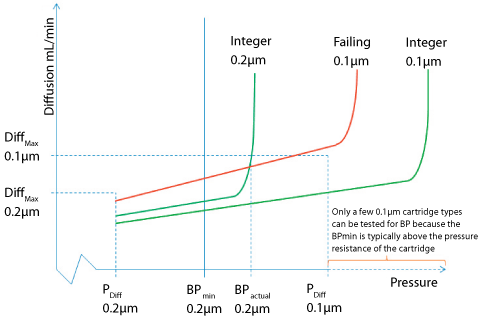
The diffusion value of a diffusion integrity test that has been conducted at too high a pressure, but still gives a conform test result, could be extrapolated down to the value one would have had if the test had been conducted at the correct pressure without risking a false conformity test result. The only risk is an over estimation of the diffusion value, thus risking a false failed-test result; however, there is no risk for any false passed-test result. On the other hand, the diffusion value of an integrity test that has been conducted at too low a pressure could not necessarily be extrapolated up to the value one would have had if the test had been conducted at the correct test pressure (see Figure 1). The risk of conducting a diffusion test at too low a pressure is a false passed test.
Wrong test limit
Filter suppliers also use different test limits for a given size of filters. The test methods may have the same name such as water intrusion test (WIT) but may measure different things. The WIT from supplier A expresses the measured value as a gas flow; the WIT from supplier B expresses the measured value as a water flow. Supplier C uses cartridge-specific factors that are only available from that supplier.
No test approach is better than the other; however, the person doing the programming must be aware about the differences. The WIT value from suppliers A and B can easily be converted one to the other by Equation 1:
Equation 1
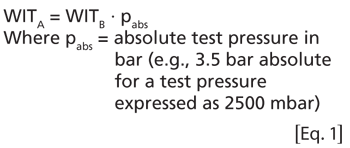
This means that if the person doing the programming sets the parameter for a WITB using the max value for a WITA the risk is to get false passed-test results. If the max value for a WITB is used when programming a WITA most likely the test results will be repeatedly false-failed.
Using a barcode scanner when entering data during programming allows the operator to select the correct program, thus minimizing the risk of using the incorrect test program. The filter supplier can confirm the correct test parameters to avoid using the wrong test parameters.
Equation 2
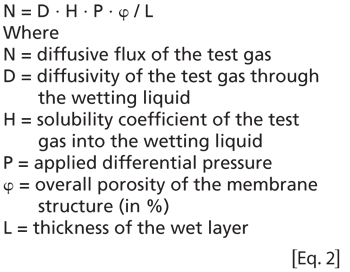
Influence from the type of test gas
When performing a diffusion test (forward flow test) or a pressure drop test on a filter, the type of test gas has to be considered. The maximum allowable diffusion value for a cartridge is typically given for air as the test gas if no other gas is stated. As nitrogen (N2) has a lower solubility in water than air, the diffusion rate for a given filter will be reduced as it follows well-established laws of diffusion (see Equation 2):
[Eq. 2]
If nitrogen is being used instead of compressed air, the maximum allowable diffusion rate must be modified accordingly to avoid false passed test results (see Equation 3):
Equation 3

In fact, the use of nitrogen instead of air simply lowers the diffusion but keeps the same over proportional increase when the bubble point is reached (see Figure 2).
Figure 2: Comparison of air and nitrogen as the test gas. BP is bubble point.
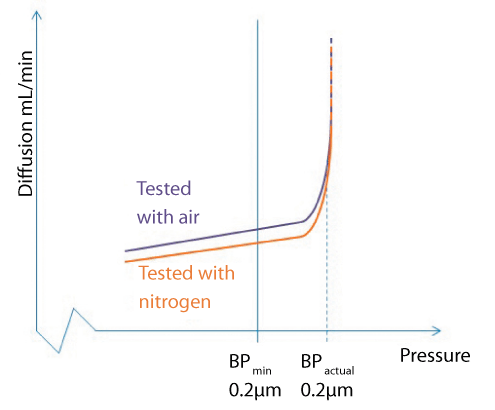
The laws of bubble point do not take solubility into account but rather the surface tension of the wetting liquid (see Equation 4).

The water intrusion test is also not influenced notably by the use of nitrogen instead of air as test gas because the contact surface between the gas and the water is limited. No significant amount of gas is dissolved into the water during the test.
If compressed air and nitrogen are available at the point of use, color coding must be used. Different connection types may also be used to avoid connecting the integrity testing device to the wrong pressure source.
Impact from the temperature of the test gas
All filter integrity testing methods using pressurized gas are bound to the ideal gas law. There is no significant difference if the test is called diffusion or forward flow or if the testing device is measuring pressure decay or flow. All pressure-based integrity testing is influenced by temperature variations.
One of the prerequisite conditions for integrity testing is stable temperature. If the device is pressurized with cold compressed gas, the heat exchange between the test gas and the filter housing will cool the housing and heat the gas. As the housing is at a lower temperature than ambient due to the cooling effect of the test gas, the environment will heat the housing and slowly bring both the housing and the test gas to ambient temperature (see Figure 3).
Figure 3: Changes in housing and test gas temperature.
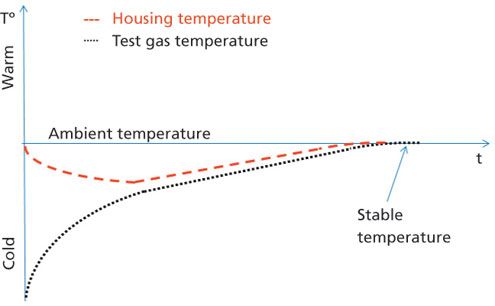
If the measurement phase starts before the temperature is stable, there could be a significant impact on the measured value. A temperature change of only 1 °C inside the filter housing during the measurement phase of 5 minutes may induce an error of approximately 20-40% depending on the test value.
Calculation:
- The test pressure is 2500 mbar gauge or approximately 3500 mbar absolute.
- The typical diffusion value for a 10” filter is 12 mL/min for a max diffusion value of 18 mL/min.
- The typical test time is 5 min.
- The typical net volume is 1400 mL
For diffusion, Equation 5 is used:
Equation 5
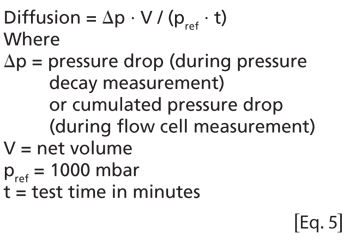
The pressure drop under isotherm conditions is:
Δp = 12 • 1000 • 5/1400 = 43 mbar
The pressure change under isovolumetric conditions due to temperature variation is expressed by Equation 6:
Equation 6
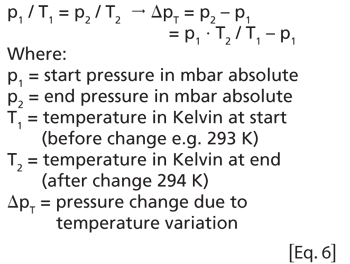
A temperature change of 1 K will give the following:
ΔpT = 3500 • 294/293 - 3500 = 12 mbar
The percentual influence Δ% is calculated as follows:
Δ% = ΔpT / Δp • 100% = 12 / 43 • 100% = 28%
Based on the above, it is of utmost importance to have isotherm conditions for all used components and fluids. But even if the temperature is stable, the temperature must be within a certain range compared to the validated test conditions. The temperature influences the solubility of the gas and the surface tension of the wetting liquid and will have an impact on the test value as shown in Equation 2.
Testing conditions can be greatly improved with longer stabilization time for temperature equilibration rather than using a long measurement time.
Conclusion
The establishment of a comprehensive FMEA for FIT is often beyond the reach of the end user alone due to the complexity of evaluating the impact from external elements on the test result. The supplier of the integrity test device may have a pre-established FMEA that could help. An audit by the supplier upon installation of the devices would allow further identification of specific risks and could contribute to setting up comprehensive standard operating procedures.
Solid training for the end user is needed to provide a full understanding of factors such as environmental influences. Training is also mandatory from a regulatory point of view.
References
1. Parenteral Drug Association, Sterilizing Filtration of Liquids, Technical Report 26 (Bethesda, MD, 2008).
2. Parenteral Drug Association, Sterilization Filtration of Gases, Technical Report 40 (Bethesda, MD, 2005).
All figures are courtesy of the authors
Article DetailsPharmaceutical Technology
Vol. 40, No. 4
Pages: 66–69
Citation
When referring to this article, please cite it as M. Stering, “Failure Mode Effects Analysis for Filter Integrity Testing," Pharmaceutical Technology 40 (4) 2016
